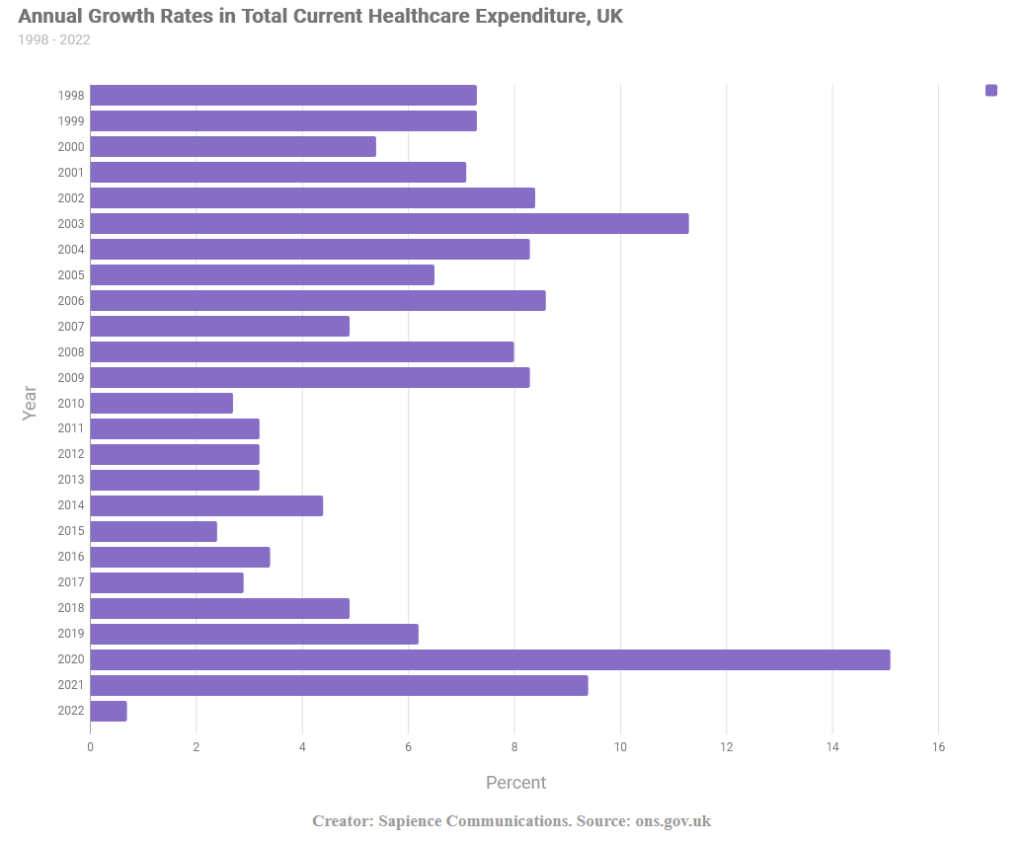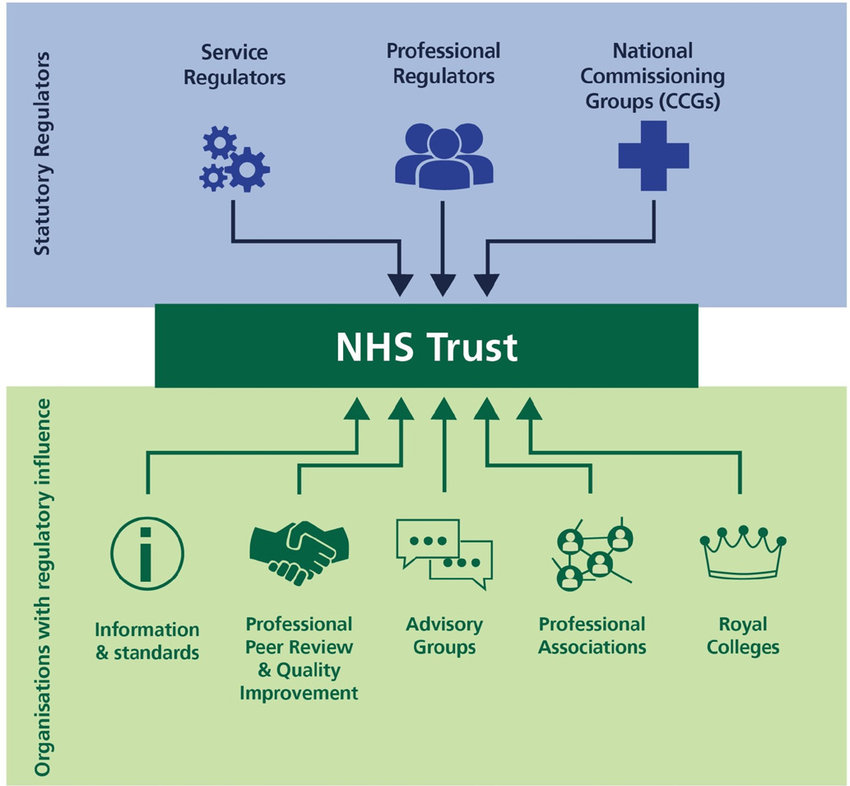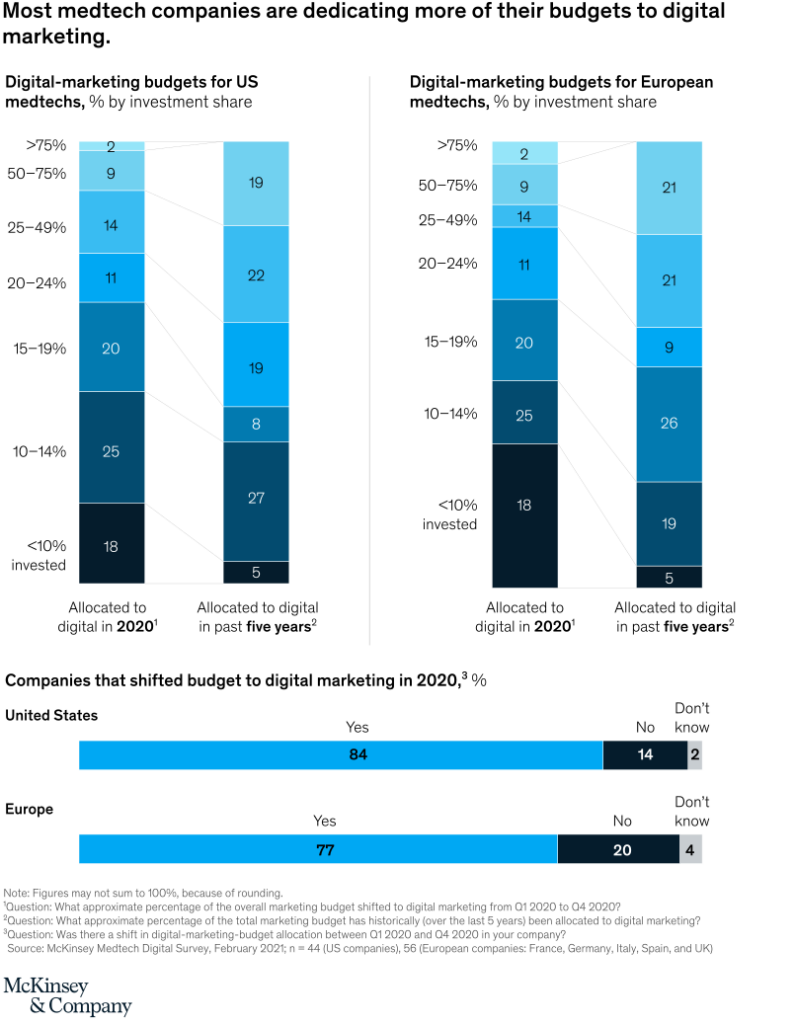The demand in the healthcare sector is on the rise driving new business, new services, new innovations etc. In 2021 healthcare spending in the United Kingdom (UK) stood at 276.6 billion British pounds, an increase of 19.1 billion British pounds compared to the previous year. And although in 2022 total healthcare expenditure grew by only 0.7% in nominal terms compared to 2021, partially influenced by the 1.1% reduction of Government expenditure after the coronavirus (COVID-19) pfacceandemic, non-government financing of healthcare grew by approximately 9.5% in 2022.

In 2021, healthcare digital advertising spend overtook healthcare TV ad spend for the first time.
Healthcare organisations of all shapes and sizes, from healthcare providers and life sciences companies to healthtech startups and disruptors, face the challenge of cutting through the noise in an increasingly crowded and competitive space.
Like in the past, PR can prove to be an efficient tool to elevate a brand’s reputation and help it stand out in its market. However, in order to adequately address the various audiences, a successful PR strategy now needs to blend traditional communication methods and channels with modern digital PR techniques. This guide aims to cover all the important aspects of strategic PR to help your healthcare brand stand out as a thought leader, a safe choice, and a reliable partner.
Table of contents
What makes PR for the healthcare sector different
Whilst public relations will generally follow more or less the same principles regardless of the industry, two key aspects of every PR campaign is to properly know your audience and understand the constraints (or opportunities) of the environment. In that respect, the healthcare sector can be rather different compared to others, because much of it is directly managed and delivered by public institutions (apart from the US), the right to health is a fundamental part of the human rights, and the legal and ethical frameworks that govern it are usually much more detailed and strict.

The healthcare sector is highly specialised and regulated
Accurate communication in the health sector requires specialised knowledge but also a high degree of empathy. In addition, the industry is subject to rigorous regulation by government bodies and professional organisations, adding an additional layer of complexity to PR strategies.
As such, the PR team bears the responsibility of conveying the message in a suitable manner that is comprehensible to different categories of stakeholders, it follows the established standards of public health communication, and leaves no space for misinterpretation.
Healthcare communication is a sensitive business
Due to the sensitive nature of health-related matters for individuals and society, healthcare providers have an increased responsibility for accuracy and foresight, whilst the PR specialists always need to bear in mind aspects like privacy, patient rights and social norms, as well as understand current ethical concerns. In fact, 47% of people are concerned that the health-related information they find is trying to sell them something, rather than provide accurate information that answers their questions.
Effective public relations in this vertical must take into account the emotional element of communication. It requires a balance between delivering precise information, fostering trust, and addressing concerns with empathy.
Healthcare organisations have a very large list of stakeholders to manage
These stakeholders include:
- In the public sector: governmental institutions, public bodies, NGOs, educational institutions, patients, healthcare professionals, the general public etc.
- In the private sector: research & development companies, technology businesses, health & beauty companies, service providers, investors, insurance etc.
As a result of that, different considerations exist for different stakeholders, ranging from budgets to tactics, tone of voice, and more.
For some of these public relations can play a key role in driving results, help engage the stakeholders and cultivate long-term partnerships, whether it’s businesses delivering services or selling products, or public bodies looking to instil societal changes in order to improve public health, such as the NHS running anti-smoking campaigns. For others traditional marketing methods, especially TV advertising, may constitute a better approach.
☘
PR challenges in healthcare and how to manage them
1. Balancing consumer well-being and business needs
Successful communications campaigns in the healthcare sector require skilful navigation between transparency, privacy, accuracy, and legal and social considerations. When engaging with the public, it becomes crucial to keep in mind what the business goals ultimately are whilst remembering that the well-being of individuals and their privacy should never be sacrificed in the name of business KPIs.
How a PR agency would approach it
An experienced PR team is well-read in the complexities of privacy regulations and is up-to-date with the latest best practices, whilst having a firm grasp of the Barcelona Principles and sufficient hands-on experience to understand that its responsibilities don’t end with showing positive business results, but they apply well-before and beyond that point. Drawing upon this extensive knowledge, the team must establish comprehensive guidelines and protocols for managing private information within and outside the organisation.
This detail-oriented approach ensures that the organisation maintains clear and transparent communication regarding privacy practices and policies, while also obtaining the needed consent regarding any personal information, where this applies.

2. Meeting the complex regulations
Along with the privacy regulations comes compliance with legislation for advertising in this sector, depending on the region or the niche of the industry. In the UK, for example, there are specific requirements relating to marketing medical products (The Human Medicines Regulations 2012), which cover a wide range of situations and details. Furthermore, the Blue Guide: advertising and promoting medicines has a section titled Reporting to the public on medicines: Advice for journalists and patient organisations (PDF, 144 kB) that should be of particular interest to the PR specialists.
Similarly, The Prescription Medicines Code of Practice Authority (PMCPA) has developed a guide in 2024 helping pharmaceutical companies use social media (PDF, 2.28 MB) whilst following the established legal requirements. It covers aspects like mentioning and tagging other social media accounts, using hashtags, linking to external resources and taking the necessary steps to ensure that the various stakeholders are not inadvertently affected the actions of the social media account managers.
The consequences of overlooking any of these regulations can be significant, and not just in terms of business. Apart from the potential financial loss or the prosecution of executives, one of the hardest blows to recover from in a highly sensitive sector like healthcare is damage to the brand.
How a PR agency would approach it
PR professionals may not have encyclopedic knowledge of all the regulations (that’s what legal specialists do after all), but they usually have a foundation to know what important statements can be made and in what context. Unlike in-house marketing teams, they have the advantage of working on multiple projects and multiple clients and learn more as a result. Beyond that, most PR agencies have their own legal department or collaborate with such specialists, which is an increasingly necessary knowledge to bring to the table.
3. Addressing misinformation
The internet didn’t just democratise access to information and real-time communication; it also flooded the general public with misinformation, bad science, and dangerous advice, with potentially disastrous effects for individuals. Healthcare institutions and companies need to confront misinformation and educate the public, but they also need to be more vigilant than organisations in other industries to ensure that they don’t inadvertently perpetuate misinformation via their numerous communication channels.
In that respects, PR-ists can help catch and address bad information by closely monitoring the media directly or through specialised tools, as well as by keeping an eye on – or approving – all the organisation’s messaging.
How a PR agency would approach it
It’s not always cost-effective for healthcare businesses to use specialised media monitoring tools to ensure their brand names are adequately represented and no misinformation has made its way into their communications, especially if they’re not large enough and well-funded. PR agencies, on the other hand, are more likely to already use such solutions as part of their regular arsenal and be able to quickly and expertly deploy them as and when needed.
Another advantage they may have is the extensive experience coming from previous cases in terms of what the best approaches may be to deal with unexpected effects of misinformation, help the executives prepare for media interviews, conduct ad-hoc public surveys, or simply manage the stakeholders’ expectations.
4. Managing crisis communications
Crises are unavoidable, regardless of the industry or region. What healthcare organisations can do is to thoroughly prepare to address such crises, whether that means developing a crisis response plan, training various team members, research the legislation and perform regular risk assessments.
In healthcare crises can range from misinformation rapidly spreading online and impacting the general population to medical errors and product recalls, to infectious disease outbreaks and public image scandals. 69% of business leaders reported experiencing a crisis over a period of five years, with the average number of crises being three.

PR professionals must be well-equipped to swiftly and effectively respond to such situations. In these instances, the main goal is to handle crisis communications in order to mitigate reputational harm and uphold public trust.
How a PR agency would approach it
Planning before anything else. An experienced PR agency would start by performing an audit to obtain a clear understanding of the client’s context, product or services, their history and any other relevant details that could present a reputational risk. Based on the findings, various approaches will emerge and, together with an in-depth risk assessment, a suite of crisis communication strategies or plans will be presented to the client. Different routes are also possible, depending on budgets and other considerations.
As Michael Falk, the CEO of Agera PR, puts it in an article for the GlobalCom:
Companies need to focus on building brand equity and reputation by communicating their values, mission, and culture consistently. They should engage with their stakeholders, including customers, employees, investors, and the media, to promote transparency and establish trust.
☘
Benefits of PR for the healthcare sector
Considering the nature of the industry, public relations can play a key role in managing a company’s public image, increasing the brand awareness and establishing it as the go-to source for a particular product or service, as well as drive new business. Being interdisciplinary and involving experts from various areas of digital marketing like social media managers, technical SEO specialists and data analysts, but also experts such as market researchers, economists, journalists, and researchers, PR can bring all those skills and views into one coherent vision to drive success.
Brand credibility
For consumers and governments, safety is a major priority; but the history, credibility and values of the brand matter as well. Whilst the safety of the heath-related products and services is nearly everywhere legally enforced, the image of a brand can be heavily influenced by the public perception of it, its past mistakes, or things that the representatives say in public. The reader can consider for example how Elon Musk went from being a favourite of the public and a media darling to being considered a liability for all the brands he’s running. In another example, Theranos founder, Elizabeth Holmes, went from being the world’s youngest self-made billionaire to being convicted of fraud.
Trust is hard to acquire and easy to lose. However, Sandra Sucher and Shalene Gupta in their book, The Power of Trust, that companies can regain trust by being “the real deal”; organisations, they say, should be:
creating valuable products and services, acting on good intentions, treating people fairly, and taking responsibility for how an organization impacts business and society
A good communication strategy and corporate social responsibility (CSR) can also aid your healthcare advertising strategy in order to make the most of your allocated budget, as the costs for advertising keep increasing. Healthcare digital ad spend in the US is projected to increase by 10% in 2024. In this competitive landscape, businesses can gain an edge by showing creativity and move fast to keep up with the market demands and the latest tech innovations, but also the ever-changing legal frameworks.
Thought leadership
Healthcare organisations and educational institutions, both private and public, often innovate or create viable solutions that go unnoticed by the wider public. PR services can help demonstrate the genuine value of an organisation’s solutions, and could help it position itself as a thought leader and be the first brand consumers think about for that type of solution.
Through securing media coverage and speaking engagements, and by strategically publishing and distributing thought pieces and insightful research-driven analyses, PR professionals can help businesses show their expertise, innovation, and ability to respond to the needs of their audiences, maintaining their existing – or stepping up into a – leadership position in the industry.
Stakeholders engagement
As mentioned above, healthcare providers collaborate with a diverse list of stakeholders, ranging from patients and healthcare professionals to government agencies, insurance providers, and advocacy groups. Each stakeholder group has different needs, profiles, and operates within different contexts, resulting in the distribution of messages about your healthcare brand in countless directions.
Your PR team’s regular activities should include monitoring various channels in order to gain insights about the perception of your brand, especially in terms of how the most impacted stakeholders feel about it. This may involve keeping a very close eye on the various social media platforms, specialised web forums, the media, your competitors, and even brand citations and backlinks from across the internet. The information will assist your team in managing the brand’s presence by facilitating appropriate and timely communication, addressing potential concerns, and engaging stakeholders efficiently and positively.
In a 2020 research piece from Accenture, 82% of healthcare providers say they’ve seen pharma companies change their communication by delivering support to their needs in addition to the required product information; for example, education materials on how to better treat patients remotely.

Reputation management and crisis communication
As stated above, PR agencies that offer reputation management & crisis comms services usually have quite a bit of experience in planning for crisis scenarios and handling corporate reputational risks. The worst thing an organisation can do in the healthcare sector is not to prepare for crisis situations, and rather than trial various strategies and tactics, working with communication specialists is likely a much better approach.
In a crisis, our team will proactively communicate with your stakeholders and the media – and ensure that the facts are represented accurately – so that you’re always ahead of the story.

☘
Common PR services for the healthcare industry
Branding and strategy
One way to differentiate on the market is for your healthcare firm to have a vision, a clear direction, and robust guidance. The significance of branding and strategy activities lies in their ability to shape and define a company’s identity, positioning, and overall direction.
You can rely on your PR team to develop a distinctive brand identity that portrays your organisation as a trustworthy entity, distinguishing it from competitors while nurturing relationships with all stakeholders. A clear strategy and genuine branding include market research and analysis, brand story development, the establishment of brand guidelines, strategic positioning and messaging, facilitating partnerships with stakeholders, and ensuring coherence across all elements of the strategy.
Research-driven content marketing
This is a common healthcare strategy for building credibility and engagement for the brand.
Content marketing is an essential strategy for fostering strong relationships with the audience by delivering high-quality and relevant content. Thus, it is a must for the content to be research-driven, fact-checked, and thought-provoking. Furthermore, it should present a clear storyline that captivates the audience, ensuring that the content pieces connect and lead to new discoveries.
Whether it be through engaging videos for popular podcasts, informative articles in trade journals, or comprehensive long-form research reports, this approach ensures the organisation’s knowledge and capabilities are showcased in diverse and accessible formats. In fact, 89% of healthcare marketing executives say their organisations use content marketing. By leveraging these different forms of communication, the brand can reach a wide audience and be more convincing.
Thought leadership
You can expect your PR team to take the responsibility of positioning your healthcare organisation and key people as thought leaders in the industry. They proactively seek out opportunities for speaking engagements, panel discussions, and guest articles to highlight your expertise and unique perspectives. The goal is to cultivate strong relationships with stakeholders by positioning your organisation as a respected and influential leader worth listening to, following, and trusting.
Media relations & media training
A professional PR team cultivates and maintains relationships with key media contacts to strategically position the healthcare brand and convey a compelling narrative for the organisation. This involves crafting a message with authority, accuracy, empathy, and timeliness, and effectively disseminating it through various media opportunities. Whether it be through interviews with key journalists, presentations at conferences, or collaborations with influencers, the PR team ensures that the brand’s story is shared authentically and resonates with the intended audience.
Social media management
Social media plays an important role in many healthcare PR strategies as it provides a direct avenue for initiating conversations with the public. It serves as a direct channel for engaging and connecting with target audiences in a meaningful way.

The core focus lies in identifying the primary target audiences and determining their preferred social media channels. By understanding their preferences and behaviours, the PR team can develop a social media PR content plan that aligns with the overall communications strategy. This ensures consistent messaging and a cohesive approach across all communication channels. In 2020, 1 out of 5 medtech companies redirect 50% of their marketing budget to digital compared to 20% 5 years ago. The aim is to genuinely engage the audience through interactive and informative content, fostering discussions, and responding to inquiries and feedback.
Search engine optimisation
As part of the marketing strategy, search engine optimisation (SEO) overlaps quite a bit with the digital public relations efforts. Knowing that 7% of Google’s daily searches were health-related, equivalent to 70,000 every minute, might make it crucial for your brand to appear in these search results. The organisation’s website is its digital business card that often comes along with PR communication. As one of the main communication goal is to be consistent across all the channels, implementing SEO alongside with PR and content marketing can build up the brand’s image perception.
Common SEO PR initiatives involve improving the website’s visibility in search engines, obtaining authentic connections with (and backlinks from) industry websites, implementing digital PR campaigns supported by SEO strategies, and more. Integrating SEO into your PR efforts, allows you to optimise your online presence, increase brand exposure, and effectively engage with your target audience.
Internal communication and employer branding
Employees are a frequently overlooked stakeholder group, yet they possess the potential to become a powerful channel for amplifying your brand voice when approached effectively. As members of your organisation, they can be the first to distribute relevant positive information about your brand. Therefore, internal communication takes its relevant place in a healthcare PR strategy.
A recent survey found that 74% of employees have the feeling they’re missing out on company news because the internal communication department is non-existent or doing a poor job.
Engaging employees involves sharing organisational plans, aligning them with the overarching message, and fostering a sense of inclusion in decision-making processes. By doing so, you can cultivate dedicated allies in the mission of building a trustworthy brand. The PR team takes on the responsibility of personalising the message and providing training to management on effective, empathetic, and timely communication with employees. Prioritising internal communication means accessing the potential of your workforce to support and reinforce your brand’s reputation and goals.
Reputation management
94% of healthcare patients use online reviews to evaluate providers. Reputation management implies actively monitoring and managing the organisation’s reputation across all possible direct and indirect channels. PR experts are responsible for monitoring online reviews, addressing negative feedback promptly, and implementing strategies to enhance positive sentiment. Understanding the vulnerabilities of the brand and its competitors is key, enabling PR professionals to respond swiftly and strategically to leverage any advantage.
Furthermore, PR efforts extend to identifying key leaders within the healthcare organisation and providing counsel to senior executives. By building a strong personal brand for these leaders, the overall brand image can be significantly improved. This may involve creating opportunities for leaders to showcase their expertise in medical forums and other relevant platforms, allowing them to establish credibility and trust within the industry.
All types of healthcare organisations can benefit from effective PR and digital marketing efforts framed within a coherent strategy.

